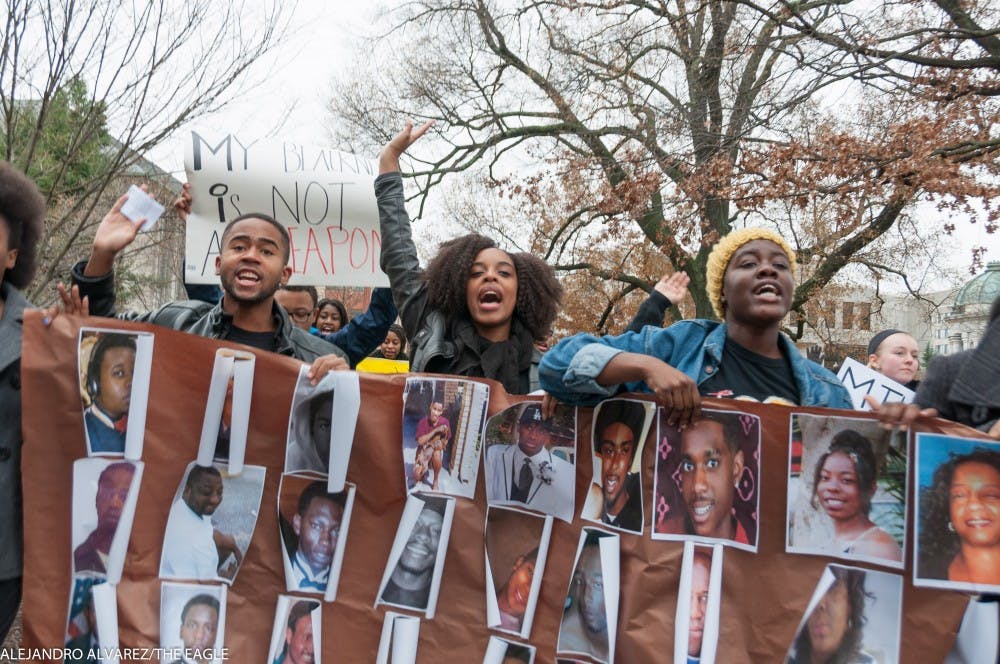Close to 100 students gathered for a “die-in” in front of the Mary Graydon Center to support the Black Lives Matter movement on Dec. 3, and the protest swelled to over 200 students and faculty members as the group then marched across campus.
The gathering was organized by junior Tatiana Laing and seniors Fito Akinrinade, Shannon Trudge, Chante Harris and Marie Pagan. The women organized the protest after they became increasingly upset by the University’s lack of reaction to the Ferguson decision and anonymous comments made by AU students against the Black Lives Matter movement on the social media platform Yik Yak, Laing said.
Akosua Bamfo, a senior in the College of Arts and Sciences, participated in the march and said that the action represented a huge step forward for AU toward understanding racial inequality at AU and in the United States.
“I feel like AU represents America as a whole, so if we’re quiet about things [or] we’re complacent about things, then we’re never going to see any change,” Bamfo said.
Like many other protests since the Ferguson grand jury decision on Nov. 24, students laid on the ground and steps of MGC for four minutes and 30 seconds to symbolize the four hours and 30 minutes that Mike Brown’s body was left in the street after he was shot by Ferguson Police Officer Darren Wilson.
During those four minutes, Harris said she thought of the black men and loved ones in her life and how she could not imagine their bodies being left there for so long.
“I feel like AU represents America as a whole, so if we’re quiet about things [or] we’re complacent about things, then we’re never going to see any change,” Bamfo said.
The students then marched around campus chanting slogans such as “black lives matter,” “hey hey, ho ho - those racist cops got to go” and “What do we want? Justice. When do we want it? Now.”
The protest sought to spark a campus conversation about race, inequality and “institutionalized racism.”
“[Institutionalized racism is] a systematic form of oppression through the institutions that are supposed to guarantee freedom,” Harris said.
President Neil Kerwin released a memo to the AU community on Dec. 2 that addressed racial issues and sexual assault as two current national topics that merited attention on AU’s campus as well.
“I write to the American University community now because these events have brought us to a tipping point,” Kerwin said in the memo. “To the extent that our campus is a reflection of the nation, we must challenge ourselves to recognize and confront these issues and set the highest standards possible for the quality of our thinking and our conduct.”
Some of the protesters, including Kadeem Collins, a senior in CAS who participated in the protest, said he believed that AU took an important first step as an institution. AU needs to be behind change whether in divestment, immigration or race, he said.
“I think that race can be very uncomfortable for people to talk about, so I was really impressed with the turnout, because we showed we’re not uncomfortable talking about race we show that we are open to beginning the discussion about what’s happening in our society,” Collins said.
Laing did not think that Kerwin went far enough in addressing issues regarding race and the Ferguson decision on AU’s campus specifically.
“Collectively we’re happy that the school was saying something about it, but we didn’t think that it enough,” Laing said. “We thought it was reactionary and that it wasn’t proactive.”
Not all AU students have reacted positively to students engaging in Black Lives Matter protests. On Dec. 1, Laing was faced with negative comments from other students when she participated in a walkout at 1 p.m. and profanities and racial slurs on social media sites, she said.
“All over social media, ever since the Ferguson decision, AU students have been expressing their opposition to the Black Lives Matter movement and to the students here at AU who are proponents for that movement,” Laing said.
The organizers said they hope that the sheer number of students, faculty and administration who came out in support and the palpable energy immediately after the march indicates the start of a spark to a continued conversation on-campus.
“I think people are going to be forced to listen and pay attention,” Bamfo said.





